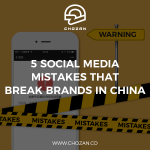China has become the world’s second-largest FMCG market and the largest ecommerce in the last decades, thanks to its rapid expansion. According to the China Internet Network Information Center, 27.3% of customers only shop on traditional e-commerce platforms in the last 6 months (before 2022.6); at the same time, the number of consumers shopping on short video platforms grew to 49.7%, and other local shopping services including fresh shopping, community shopping and WeChat, 27.3% of customers made 37.2%, 32.4% and 19.6% respectively.
Social platforms are commonly used to connect and communicate with others. Through these natural personal networks, Chinese social commerce platforms take advantage of valuable customer connections. Social commerce builds up a new format of retail, where customers can shop within social platforms from their willingness to purchase and share to completing the transaction. It bridges the relationship between people and the various shopping situations.
Below are 10 innovations in social commerce from two categories, which are customer experience and community networks for brands to learn how to convey the best possible image of their brands and communicate better with their customers through social commerce platforms.
Part One: Improved-experience consumer journey
By leveraging the features of social commerce platforms, brands can simplify and upgrade the consumer journey. Most importantly, learning from successful cases at an early stage keeps your brands ahead of the trends rather than following common practices.
1. Brands could reach billions of users with social networks.
As we know, WeChat has over 1.2 billion monthly active users. WeChat Channel is a feature in WeChat that integrates and connects short videos, live streams, official accounts, direct messages, and mini-programs of shops or customer loyalty programs. The seamless journey from the social platform to the shopping destination.
Some features updated in WeChat Channel for social commerce in a high frequency in 2022 (Source from WeChat)
Take Estée Lauder, for example, the WeChat platform becomes a new “official website” of the brand, providing the full range of services from communication to after-sales service.

Estée Lauder’s WeChat account provides entrance to livestream reservation, WeChat Channel short videos, product display, customer service contact, and mini eshop.
2. Top brands are active in low-carbon activities and promote green products
To meet the trends of green and low-carbon, Alipay launched a platform called “88 low-carbon accounts” this year, which covers over 70 situations and partners with 19 corporations. Customers can earn reward points and virtual medals for purchasing eco-friendly goods.

Alipay promotes its “88 low-carbon accounts” to activate green shopping
During this year’s Double 11 more than 1.63 million items on Tmall were labelled as green and low-carbon friendly, covering categories such as clothes, beauty, food, and energy-saving electronics. Shiseido and Unilever both participated in this sustainable shopping journey.
3. Gamify the shopping experience with social commerce platforms
As a platform that never bores users, Pinduoduo ranks 3rd place among key Chinese e-commerce players. The original team came from game production, thus Pinduoduo adopted multiple product design and operation methods from the gaming industry. As soon as users open the Pinduoduo App, they can see the dynamic icons of limited-time shops, cut-price sales, low sales, etc., giving the impression of entering a world of treasure hunts.
Reasons people try on a marketing game (source)
Easy to play, multiple formats, and the ability to interact with friends are the main reasons for Chinese consumers to choose.
In addition, brands use game product concepts of “set a goal – create a threshold – behave through the threshold – achieve the goal“, but the complexity of the game and the clearance cycle is growing. During the Spring Festival, not only Yili, but Huawei and Casio also adopted gamified marketing methods.

The dairy brand Yili launched Match 3 Game to attract new and young customers particularly.
4. AR and 3D experience for shopping online
The Metaverse hasn’t reached its end yet, and e-commerce platforms want you to see a preview of it. With the latest version of the TMall app, if a customer wants to buy a refrigerator, for example, consumers can use their mobile phone to project a 3D projection of the refrigerator at any location in the house.
TMall 3D shopping, immersive experience Double 11 (source)
Using AR projection, you can view the size of the room and the actual effect of placing a product in the house in a 1:1 ratio.
Unitree robotic dog, Vitra cloud chair and bearbrick brand display in the TMall 3D space (source)
5. Diversify category when brands utilise KOLs and KOCs
As the leading livestream platform, Douying attracts a number of top anchors from a variety of fields, such as sports, technology, and education. It indicates that the trends of the hottest live streamers can change rapidly. Since Douyin is more likely to endorse livestreamers from different backgrounds based on its algorithms, the scene and cross-track would represent a major breakthrough for brands.

As new categories are emerging in the livestream attracting more attention, from education to sports, brands can cooperate with new anchors to strengthen relationships and be patient with the results. Big MCNs also provide opportunities for anchors with high potential. For example, Austin Li also encourages his team members to grow into anchor roles to maximize sales.
Part Two: Community-oriented promotion
Social platforms naturally build real networks among users. In terms of social commerce, brands rely heavily on recommendations and shares from friends. How to benefit from the relationship between customers and attract new customers from referrals is an important lesson to learn.
1. WeChat group and WeCom play a significant role in customer relations
WeChat groups are self-established virtual communities based on WeChat contact, interest, offline events or face-to-face socialization. This year Pop Mart started establishing groups through WeCom (WeChat for work), with multiple functions such as auto-reply, better service, fast communication, data analysis and management, etc. In addition, brands can observe real needs and feedback directly from customers through group management.
Pop Mart is an influential art toys and collectible toys company in China. Its WeChat mini program generated revenues of $898 million in 2021, up 92.6% year-over-year. According to incomplete statistics from Pop Mart, it has close to 30,000 groups on WeChat, 90% of which are spontaneously established by customers.
Pop Mart WeChat Account followers can get into the virtual community in WeChat group (source)
2. Group managers turn into group-buy leaders
As we mentioned above, WeChat Group is widely used in China due to its large user base. Kuaituantuan might be a strange name for readers. It comes from Pinduoduo and played a significant role during the Covid period in Shanghai. Instead of a mutual ecommerce platform, it’s more like a tool to help group leaders organise shopping together.
Based on WeChat mini programs, Kuaituantuan could be used in group communication and with individuals. It provides group leaders with automatically generated forms that can help the head of the group quickly process collections, refunds, etc. Furthermore, the beauty brand Perfect Diary launched a group purchase of 100 people to achieve rapid product sales.
Kuaituantuan is providing all categories of products directly to the customers based on their social networks/ WeChat Groups (source)
3. Livestream commerce platforms have different mechanisms and results
As we mentioned above, some livestreamers accumulated followers quickly on Douyin and also joined other platforms for product promotion. Different platforms perform differently through recommendation systems, layouts and CX logic, etc.

Taobao Live, WeChat Channel Live and Douyin Live play in different ways, it varies from centralized to decentralized recommendation
Under the new ecological anchor strategy of Taobao Live, for example, talented new anchors would be quickly identified and supported by traffic and goods. This would enable them to reach the brand in a short period of time.
4.Cross-brand and cross-category cooperation
Cooperation between brands is not new, but expanding the fan base via connecting cross-categories is the new normal. Beyond FMCG brands, co-branding may involve IT companies, offline activities, or both, as long as the competitors all lead to the expansion of the customer base.
Over a hundred brands cooperate with Yongpu Coffee
Yongpu Coffee is a local Chinese brand making instant coffee. Starting in 2014, Yongpu Coffee cooperated with over 36 brands and 500 campaigns to attract attention and convert new customers. Not only in the FMCG industry but also with music apps, IPs, offline art museums, etc. It also cooperates with another well-known coffee brand, Manner, to leverage its offline channels for selling Yongpu Coffee products.
5. Interest community would be a new growth point
Subcommunities such as virtual products or second-hand categories show the potential for brands to grow sales. Customers are more likely to spend their time and money if they are willing to pay attention to the content or output of shoppers.
RED’s slogan has changed from “finding the goods abroad” to “finding the life you want”.
The expertise helps to build trust between buyer and seller, which is why the interest-based community would also grow into multiple KOSs and even shopping platforms, such as Duozhuayu (a second-hand book shopping platform) and RED (China’s foremost fashion and luxury shopping platform).
Conclusion
Innovations bring new growth to the market. From a customer experience perspective, brands could leverage billions of user pools on social networks, stay active in low-carbon activities, try to gamify the shopping experience with social commerce platforms, incorporate new technology like AR and 3D shopping, and diversify categories when using KOLs and KOCs, all of which contribute to more effective customer relationships.
China’s innovations when it comes to social commerce are light years ahead of those in the West. Learn from China’s innovations and see what you can implement in your business.
If your brand needs help and guidance we can help with training tailored to your specific needs or answer your most urgent questions on an expert call or a series of consultation sessions. Contact us and we’ll arrange a chat to find out what you need and move forward from there.
Read more related posts
-
Live Streaming in China: The Top 5 Platforms
Live streaming in China is becoming the most popular video format with more than 325 million online viewers in total, or 45.8% of Chinese netizens, according to The Chinese Live…
-
Live Streaming in China: The Top 5 Platforms
Live streaming in China is becoming the most popular video format with more than 325 million online viewers in total, or 45.8% of Chinese netizens, according to The Chinese Live…
-
Live Streaming in China: The Top 5 Platforms
Live streaming in China is becoming the most popular video format with more than 325 million online viewers in total, or 45.8% of Chinese netizens, according to The Chinese Live…
-
Live Streaming in China: The Top 5 Platforms
Live streaming in China is becoming the most popular video format with more than 325 million online viewers in total, or 45.8% of Chinese netizens, according to The Chinese Live…
-
5 Social Media Mistakes That Break Brands in China
Chinese social media is more than a platform for socializing and entertaining. It is full of business opportunities. It helps brands reach a mass audience and establish their brand image.…






